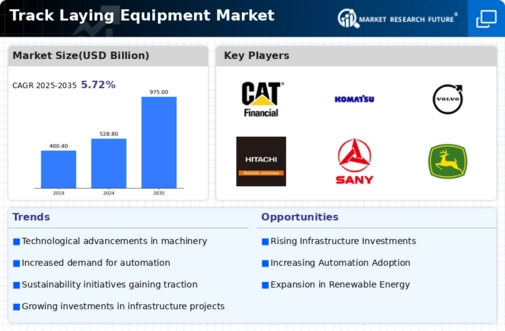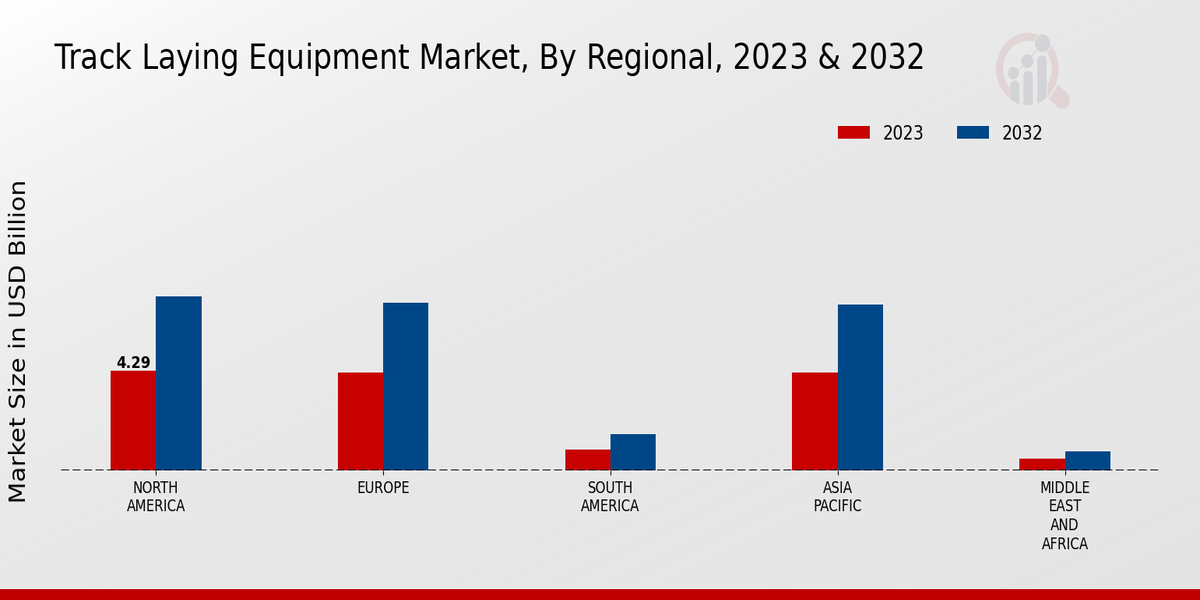Technological Advancements
Technological advancements play a pivotal role in the Global Track Laying Equipment Market Industry. Innovations such as automated track laying systems and precision engineering have improved efficiency and reduced labor costs. For example, the introduction of GPS-guided machinery allows for enhanced accuracy in track placement, minimizing errors and ensuring safety. These advancements not only streamline operations but also contribute to the overall growth of the market. As the industry embraces these technologies, the projected compound annual growth rate (CAGR) of 5.72% from 2025 to 2035 indicates a robust future for track laying equipment.
Market Trends and Projections
The Global Track Laying Equipment Market Industry is characterized by various trends and projections that indicate its future trajectory. The market is expected to grow steadily, with projections suggesting a value of 528.8 USD Billion in 2024 and 975.0 USD Billion by 2035. The anticipated CAGR of 5.72% from 2025 to 2035 reflects the increasing investments in rail infrastructure and technological innovations. These trends highlight the dynamic nature of the industry and the potential for growth driven by both public and private sector initiatives.
Global Trade and Economic Growth
The Global Track Laying Equipment Market Industry is closely tied to global trade and economic growth. As economies expand, the need for efficient transportation networks becomes paramount. Rail systems facilitate the movement of goods and people, making them essential for economic development. Countries investing in rail infrastructure are likely to see enhanced trade capabilities and improved logistics. This correlation suggests that as global trade continues to flourish, the demand for track laying equipment will also rise, further propelling the market forward.
Urbanization and Population Growth
Urbanization and population growth are driving factors in the Global Track Laying Equipment Market Industry. As cities expand and populations increase, the demand for efficient public transportation systems rises. Rail networks are often viewed as a sustainable solution to urban congestion, prompting investments in new track laying projects. This trend is particularly evident in developing regions, where rapid urbanization necessitates the expansion of rail infrastructure. The anticipated growth in the market, reaching 975.0 USD Billion by 2035, underscores the importance of addressing urban transportation challenges through effective track laying solutions.
Infrastructure Development Initiatives
The Global Track Laying Equipment Market Industry is experiencing a surge due to extensive infrastructure development initiatives worldwide. Governments are increasingly investing in rail networks to enhance connectivity and promote economic growth. For instance, major projects in Asia and Europe aim to modernize existing rail systems and expand new lines. This trend is expected to drive the market significantly, as the demand for advanced track laying equipment rises. By 2024, the market is projected to reach 528.8 USD Billion, reflecting the critical role of infrastructure in shaping the future of transportation.
Sustainability and Environmental Regulations
The Global Track Laying Equipment Market Industry is increasingly influenced by sustainability and environmental regulations. Governments are implementing stricter guidelines to reduce carbon emissions and promote eco-friendly practices in construction and transportation. This shift encourages the adoption of greener technologies and materials in track laying equipment. For instance, electric and hybrid machinery is gaining traction as companies seek to comply with these regulations. As a result, the market is likely to evolve, with a growing emphasis on sustainable solutions that align with global environmental goals.














